| Release List | Reviews | Price Search | Shop | Newsletter | Forum | DVD Giveaways | Blu-Ray/ HD DVD | Advertise |
| Reviews & Columns |
|
Reviews DVD TV on DVD Blu-ray International DVDs Theatrical Reviews by Studio Video Games Features Collector Series DVDs Easter Egg Database Interviews DVD Talk TV DVD Talk Radio Feature Articles Columns Anime Talk DVD Savant HD Talk Horror DVDs Silent DVD
|
DVD Talk Forum |
|
|
| Resources |
|
DVD Price Search Customer Service #'s RCE Info Links |
|
Columns
|
 |
The Strange Case of UNTIL THE END OF THE WORLD, Part Two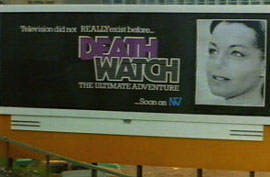 --- dedicated artists, clone concepts, and another Savant mystery to ponder.
Now Savant doesn't keep up with all the major film criticism that's printed, so please
forgive me if what I think I've uncovered here is common knowledge among real scholars of
contemporary film. But it fascinates me, and I think it's worth sharing, so I'm going to risk it.
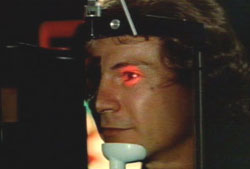 Based on Wenders' statement and the evidence of the films themselves, it would seem that in 1980 Bertrand Tavernier made his own film from the same development discussions with Wenders, La mort en direct, known by its English title, Deathwatch. I remember it playing briefly at an art house in Los Angeles and then heard little more of it until reading its review in Variety's Complete Science Fiction Reviews, editor Donald Willis,
Garland, 1985. Based on the book The Continuous Katherine Mortonhoe (U.S. title: The Unsleeping Eye) by David Compton, Deathwatch is a visionary critique of the expanding Media Society. It postulates a near-future where death by illness has been all but eradicated and where 'dying the old way' carries enormous morbid fascination for the public. Television entertainment is dominated by a commercial hit, Deathwatch. It voyeuristically shows the slow deaths of those rare individuals struck down by disease. But when TV mogul Vincent Ferriman, played by Harry Dean Stanton, has trouble securing a taping contract from the privacy-minded, terminally diagnosed Katherine Mortonhoe (a radiant Romy Schneider) he employs a new technological wrinkle: Roddy (Harvey Keitel) has voluntarily had his eyes replaced with undetectable video cameras. These 'unsleeping eyes' transmit back to the Deathwatch TV studio everything Roddy sees and hears, allowing recording without the giveaway presence of a camera. All Roddy has to do is get close to the now-fugitive Katherine, and the Deathwatch show will make documentary history: a Cinema truly Verite.
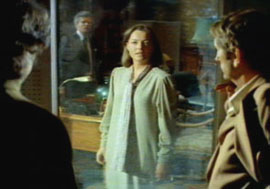 Savant doesn't normally go in for spoilers, so be warned that what follows reveals a lot about both films. But Deathwatch's television screenings are infrequent and finding a copy at Blockbuster is unlikely - both the video and laserdisc versions are pretty old and you might have to do a little searching for a rental depending where you live. If you are already an Until the End of the World aficionado, finding Deathwatch is compulsory... do so, now! The obvious similarities are that Deathwatch and Until are both films by continental directors dealing with future societies only slightly removed from our own, concerning 'vision-oriented' science fiction inventions. The following discussion starts with the 'dead-ringer' issues first and then (yes, Savant can't help himself) compares the divergent but complimentary themes of these doppelganger dramas. THE COMPARISON: DEATHWATCH / UNTIL THE END OF THE WORLD Katherine Mortonhoe of Deathwatch flees the cameras of a relentless media corporation without a known destination (except death itself), ultimately heading for a former home in a place called 'Land's End' to the West. In Until Claire flees her entire life in an illogical pursuit of Sam Farber, ultimately heading to 'the end of the earth', an incredibly remote part of Australia. The spectre of certain death hangs over Katherine, changing her values (she first refuses, then steals Ferriman's money) and motivating her to the extreme of fleeing her home life for a vagabond existence. In Until the spectre of death is a potentially Earth-destroying nuclear satellite. As the whole world trembles, Claire reacts with a series of value-bending, illogical actions: Becoming an accomplice in a robbery (stealing money), and abandoning her lover for a vagabond existence pursuing wanted criminal Sam Farber. Katherine's life as a writer of 'computer books' is disrupted by the intrusion of Ferriman's TV network. Eugene Fitzpatrick's (Sam Neill) laptop computer novel is erased by the EMP effect of nuclear detonations in outer space, and he must begin again.
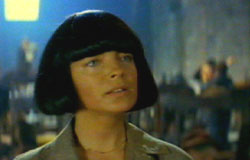 In her flight from the gaze of Deathwatch, Katherine, to disguise herself, wears a full black wig . To alter her identity (erase herself?) and fool a bounty hunter (Ernie Dingo), Claire sometimes employs a quite similar wig. Both heroines make a show of doffing their wigs with a headshake to reveal their natural, lighter hair underneath.
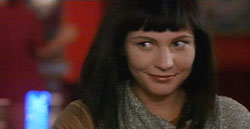 There seems to be a relationship between both movies and the 1943 noir horror drama
The Seventh Victim. Both Katherine and Claire's wigs are heavily reminiscent of the hairstyle of Jacqueline Gibson (Jean Brooks) in that older film. Jacqueline is an irrational, depressed and suicidal woman who seems to be 'racing to her own death' - just like Deathwatch's Katherine, who threatens suicide, and at one point pretends to have a fatal seizure. In Until, Sam Farber's
blind mother Edith (Jeanne Moreau), depressed by the visual world afforded her by her husband's startling invention, becomes suicide-obsessed and desires to will herself to death.
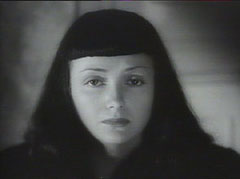 Still more: Deathwatch is dedicated onscreen to director Jacques Tourneur, the prime directing talent associated with The Seventh Victim's famous producer, Val Lewton. In Until, Claire's last name is Tourneur. During their flight together, Roddy and Katherine share an odd discussion about pygmies in Africa. A question which the pygmies put to the first explorers to reach them was, "Do you dream? We pygmies thought that only we dreamed." In Until, Sam enchants Claire with his anthropologist mother's recordings of African pygmies singing 'dream songs'. Sam himself is later cured of the 'disease of images' by sleeping between two Aborigines, who 'take his bad dreams away.' Director Wenders intimated that his unfilmed ending to Until was intended to bring the film full-circle back to Africa to the singing pygmies, and that the pygmies' harmonious communal culture represented a Utopian possibility.
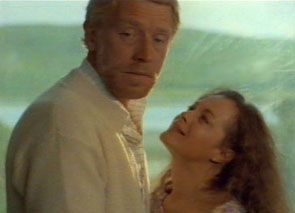 Katherine's unconscious goal in her flight is to reunite briefly with her ex-husband Gerald (Max Von Sydow) in his remote cottage at 'Land's End'. Here the helicopter-borne televison magnate Ferriman finally corners her, only to lose his prey. Claire finds that the goal of her flight with Sam Farber is actually to reunite Sam with his scientist father Henry (also played by Max Von Sydow) in his hidden cave laboratory in one of the most remote places on Earth. There the helicopter-borne American military intelligence agents finally corner the rogue scientist, only to lose the disputed invention they covet.
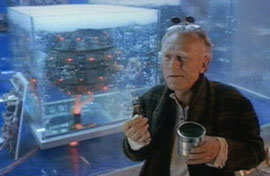 In Deathwatch, the 'visionary' invention is an undetectable camera that can bring a heightened reality to televised reality shows. The mass audience prefers the images of televison to seeing with their own eyes, prefers, in fact, living a manufactured television reality (which the profit-oriented Deathwatch show is only too happy to dish up) to living their own, real lives. The horror is that the media society demeans human values in the process, turning individuals into passive consumer-voyeurs in a zombie-like life where 'everything is interesting, but nothing matters.' Respect for personal privacy is negated. Katherine flees the pitiless scrutiny of Deathwatch because she understands she must do so to preserve her soul. In Until the End of the World the 'visionary' invention is a camera that records 'the act of seeing' so that one person's vision can be transmitted directly into the brain of another -- allowing even a blind person to see, if only vicariously. The horror element in Until has three manifestations. First, the blind already have their own sightless way of perceiving the world, a delicate psychic construction of a personal reality. A blessing becomes a curse when this secure 'personal reality' is replaced with the reality sighted people take for granted. For the gift of a few miracle visions Edith Farber 'loses her soul'. Secondly, because Farber's camera retrieves 'remembered' vision directly from the brain, it can also be used to retrieve and display unconscious memories and dreams uninterpreted, uncensored by our conscious minds. When a person views the contents of their own 'soul', the fascination can become an all-enveloping, morbid obsession that, like heroin, displaces all other concerns. The addict eventually becomes a zombie incapable of relating to anything save the enigmatic visions. This is the 'disease of images.' The final horror is only alluded to: American Military Intelligence wishes to use the invention to penetrate human minds in ways that could previously only be accomplished with crude brainwashing and torture. The invention promises limitless access to mental content regardless of the will of the individual; also, because it can implant images in the brain, it can be easily adapted to manipulate, deceive and torture with awful efficiency. Katherine's instinctive demand to retain the privacy she considers her personal posession is shunted aside by a Media World dismissive of the validity of such considerations; In Until the Aborigines' instinctive reaction to retain the privacy and sanctity of the human psyche (our dreams) is dismissed as superstition by Dr. Farber. In Deathwatch, Roddy's implanted video eyes fail and threaten a permanent loss of vision, the fear of which causes him much anguish and pain. In Until, Claire's 'disease of images' causes her similar anguish and suffering, when she's threatened with even a momentary loss of visual access to her personal 'dream images'. Both Deathwatch and Until the End of the World marvel at the possibilities of technology while showing in a plausible way how they threaten simple human values. With today's disproportionate emphasis on movie special effects, fans forget that that it is the revelatory concepts that distinguish the science fiction they most treasure. One of the reasons sci fi is so wonderful is that it is the perfect genre for communicating visionary messages. Until and Deathwatch develop and elaborate themes visited before in Invasion of the Body Snatchers, These are the Damned, Forbidden Planet, 1984, A Clockwork Orange and other films in which viewers found fantastic (but truthful) visions. It is indicative of Wenders' and Tavernier's awareness of these visions that Vincent Ferriman's office walls are decorated with posters from The Incredible Shrinking Man,
The Masque of the Red Death, and, most appropriately, "X" (The Man With X-Ray Eyes).
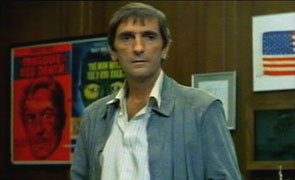 The unique relationship of Until the End of the World and Deathwatch gives an opportunity to see how two completely different but complimentary-themed science fiction fantasies can evolve from a common stem. Focusing on such commercially minor films will seem an esoteric exercise to many; Savant hopes that some of those who like to actually think about the meanings of the movies they watch will be motivated to give these wonderful pictures a good, long look.
Text © Copyright 1998 Glenn Erickson.
Review Staff | About DVD Talk | Newsletter Subscribe | Join DVD Talk Forum |
|
| Release List | Reviews | Price Search | Shop | SUBSCRIBE | Forum | DVD Giveaways | Blu-Ray/ HD DVD | Advertise |





